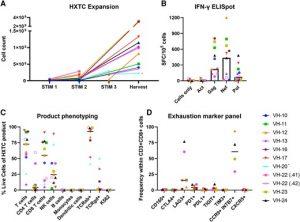While antiretroviral therapy (ART) keeps HIV in check, a hidden reservoir of dormant virus still exists within the body. This “sleeping virus” can awaken and cause acquired immunodeficiency syndrome (AIDS) if treatment stops. Researchers are exploring ways to “wake up” this latent HIV and make it vulnerable to the immune system, potentially paving the way for a cure (Figure 1).

Figure 1: Characterization of human immunodeficiency virus (HIV)–specific T-cell (HXTC) products. A, HXTCs expanded to clinically relevant levels after 2 stimulations except for VH-22, which underwent 3 stimulations (second stimulation shown as .41 and third as .42). *VH-20 failed to expand and did not proceed in the study. B, HXTCs display HIV specificity. All products produced interferon-γ in response to HIV Gag, Nef, and/or Pol peptide mix stimulation, or actin (Act) as a negative control, and measured by enzyme-linked immunosorbent spot assay. VH-13 was tested as a pool of Gag/Pol/Nef and not individual peptides. C, HXTC product phenotyping was analyzed by fluorescence-activated cell sorting, to show subpopulations expressed as percentage of lymphocytes, T cells (CD45+CD3+), CD4 T cells (CD3+CD4+), CD8 T cells (CD3+CD8+), natural killer cells (CD3–CD56+CD16+), monocytes (CD45+CD14+), B cells (CD19+), and dendritic cells (CD3–CD83+CD16+). D, Exhaustion markers of HXTC by flow cytometry. Cell products displayed overall low expression of markers associated with exhaustion. Abbreviations; ELISpot, enzyme-linked immunosorbent spot assay; HXTC, human immunodeficiency virus–specific T cell; IFN-γ, interferon gamma; NK, natural killer; SFC, spot-forming cells.
A recent trial tested a combination approach. Vorinostat, a drug, acts like a key, unlocking the tiny doors within cells where the virus hides. This “wakes up” the virus, making it visible to the immune system. Additionally, the researchers extracted white blood cells from patients, amplified their ability to attack HIV-infected cells in the lab, and then reintroduced them back into the body.
Early Findings Offer Promise, But More Work Needed:
- The combination approach showed a small reduction in the latent HIV reservoir, indicating its potential.
- However, the reductions were not statistically significant.
- One major challenge is that Vorinostat’s effects are short-lived, requiring further research on prolonged activation methods.
While the initial results are encouraging, more research is required to, optimize the dose and delivery of Vorinostat for sustained effect and further enhance the immune response to effectively eliminate the awakened virus.
This study, though not definitive, offers a glimpse into a promising future for HIV treatment. By “waking up” the hidden enemy and strengthening the immune system, researchers are getting closer to the goal of a cure.
Journal article: Gay, C. L., et al. 2024. The Effects of Human Immunodeficiency Virus Type 1 (HIV-1) Antigen-Expanded Specific T-Cell Therapy and Vorinostat on Persistent HIV-1 Infection in People With HIV on Antiretroviral Therapy. The Journal of Infectious Diseases.
Summary by Stefan Botha










